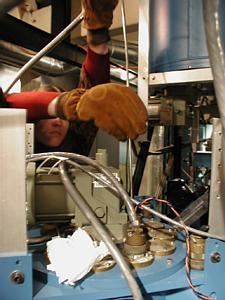
|
|
7 December, 2000
Liquid Helium Fill
Each receiver at AST/RO relies on a superconductor in its mixer to change
photons we collect from the sky into an electrical signal. (see December
6, magic) Superconductors are materials that provide no electrical
resistance to electric currents. However, they must be kept cold- very
cold. To accomplish this, inside the dewars where the mixer for each
receiver is, there is a container to hold liquid helium. Helium is a gas
at temperatures that wešre familiar with, but at 4 Kelvin (4 degrees above
absolute zero) helium becomes liquid. Filling the dewar with liquid
helium keeps the superconductors cold. However, since the helium will
eventually boil off, the dewar needs to be filled with liquid helium every
few days.

The liquid helium is kept in a large dewar, seen here with Chris Martin. This pressurized dewar will hold 250 liters. Since liquid helium is very cold, it must be handled with care. The helium as it boils off is cold enough to cause frostbite, and since the temperature difference between the liquid helium and the air in the room is so great, the liquid is never actually seen, just the gas as it boils off.

The first step to filling the dewars with liquid helium is to attach a pipe to the 250 L dewar. A valve is opened, and the pipe put down the top of the dewar. It then takes a few minutes for the pipe to cool down enough to transfer the helium instead of having it boil off inside the tube. Once it has cooled down, a small stream of gas is seen coming out of the other end of the tube, as the liquid is transferred and then boils away when it reaches the air in the room

The pipe is then put in a hole in the dewar which leads to the helium container. It takes a few minutes to transfer enough helium to fill the container. When the container is filled, the gas plume coming out of the receiver will grow dramatically. The pipe is then removed from the dewar, and taken to the next one to be filled. After each dewar to be filled has its helium, the pipe is removed from the 250 L dewar, and the valve shut. This all sounds easy and straightforward, but working with very cold substances is always a bit tricky. The pipe is very cold when it is transferring the helium, and thick gloves must be worn. In addition, the helium gas is very cold as it boils off and should be avoided. The first time I assisted with a liquid helium fill, the gas came in contact with my right index finger through my glove and I got a small patch of minor frostbite on my finger only a split second after I felt a bit of cold coming through my glove.
Contact the TEA in the field at
.
If you cannot connect through your browser, copy the
TEA's e-mail address in the "To:" line of
your favorite e-mail package.
|
